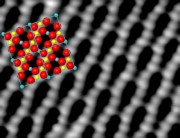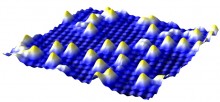This is an old revision of the document!
The Finer Details of Rust
Magnetite – A Long Standing History
 Magnetite (Fe3O4) is one of the Earths' oldest known, most naturally abundant and cost affective materials. In the bulk it exhibits interesting phenomena such as ferrimagnetism, half-metallicity, and the Verwey transition, in which almost all the properties change drastically on cooling through 123 K. Fe3O4 plays an important role in many natural and man made processes. For example, magnetite nanoparticles are present in the beaks of homing pigeons (thought to be related to the sensing of the Earths magnetic field). Fe3O4 particles can be dragged around the body using magnets to deliver drugs in a highly localized way. However, while the bulk properties are much studied, much less work has gone into studying the surfaces, which turn out to be critical to the function performed in the majority of applications.
Magnetite (Fe3O4) is one of the Earths' oldest known, most naturally abundant and cost affective materials. In the bulk it exhibits interesting phenomena such as ferrimagnetism, half-metallicity, and the Verwey transition, in which almost all the properties change drastically on cooling through 123 K. Fe3O4 plays an important role in many natural and man made processes. For example, magnetite nanoparticles are present in the beaks of homing pigeons (thought to be related to the sensing of the Earths magnetic field). Fe3O4 particles can be dragged around the body using magnets to deliver drugs in a highly localized way. However, while the bulk properties are much studied, much less work has gone into studying the surfaces, which turn out to be critical to the function performed in the majority of applications.
Fundamental Surface Chemistry
![STM image of Fe3O4(001) after adsorption of H2O [3] STM image of Fe3O4(001) after adsorption of H2O [3]](/www/_media/surface/research/fe3o4_h2o_stm.jpg?w=180) Our group has been interested in Fe3O4 surfaces since we published the first atomically resolved image of the Fe3O4(001) in 2000 [1]. In the last two years we have come back to this surface and begun to study the surface chemistry in detail. By systematically varying the preparation conditions, we found that several highly ordered metastable Fe terminated surfaces can be created [2]. The ability to tailor the surface structure in this way presents an unrivalled opportunity to investigate the effect of cation concentration and co-ordination on the surface reactivity [2].
Our group has been interested in Fe3O4 surfaces since we published the first atomically resolved image of the Fe3O4(001) in 2000 [1]. In the last two years we have come back to this surface and begun to study the surface chemistry in detail. By systematically varying the preparation conditions, we found that several highly ordered metastable Fe terminated surfaces can be created [2]. The ability to tailor the surface structure in this way presents an unrivalled opportunity to investigate the effect of cation concentration and co-ordination on the surface reactivity [2].
So far, our investigations have produced very interesting results. We have found that a small lattice distortion (which is responsible for the opening of a surface band gap) plays a huge role in the adsorption of small molecules. Covering the surface in atomic H re-metallizes the surface [3], while water undergoes a highly unusual adsorption process in which only H atoms are deposited at room temperature [4]. This mechanism is linked to the adsorption geometry in the distorted surface, which isolates adsorbed H and OH.
From Single Adatoms to Clusters in Catalysts
 Metals such as gold or palladium are often used as catalysts to speed up certain chemical reactions. When the atoms ball together, most of them do not get into contact with the surrounding gas any more and the catalytic effect diminishes drastically, but these processes are insufficiently understood. While small clusters are highly efficient catalysts, it is still unknown what happens at the extreme, where isolated metal atoms reside on the surface — it was close to impossible to have single metal atoms on an oxide surface. The Fe3O4(001) surface allows us to study both, isolated metal adatoms that are stable up to surprisingly high temperature [5], as well as the processes leading to cluster formation and growth of clusters [7].
Metals such as gold or palladium are often used as catalysts to speed up certain chemical reactions. When the atoms ball together, most of them do not get into contact with the surrounding gas any more and the catalytic effect diminishes drastically, but these processes are insufficiently understood. While small clusters are highly efficient catalysts, it is still unknown what happens at the extreme, where isolated metal atoms reside on the surface — it was close to impossible to have single metal atoms on an oxide surface. The Fe3O4(001) surface allows us to study both, isolated metal adatoms that are stable up to surprisingly high temperature [5], as well as the processes leading to cluster formation and growth of clusters [7].
Organic Molecules
Many applications of Fe3O4 contain Fe3O4-organic interfaces, yet there have been almost no studies of how organics adsorb at Fe3O4 surfaces. We are currently investigating interfaces important for biomedical and spintronic applications, which is required to understand how their properties affect the performance.
References
- B. Stanka, W. Hebenstreit, U. Diebold, S. A. Chambers
Surface Reconstructions of Fe3O4(001)
Surf. Sci. 448 (2000) 49-63 ⋅ full text* - G. S. Parkinson, Z. Novotný, P. Jacobson, M. Schmid, U. Diebold
A metastable Fe(A) termination at the Fe3O4(001) surface
Surf. Sci. 605 (2011) L42-L45 ⋅ full text* - G. S. Parkinson, N. Mulakaluri, Y. Losovyj, P. Jacobson, R. Pentcheva, U. Diebold
Semiconductor-half metal transition at the Fe3O4(001) surface upon hydrogen adsorption
Phys. Rev. B 82 (2010) 125413 ⋅ full text - G. S. Parkinson, Z. Novotný, P. Jacobson, M. Schmid, U. Diebold
Room Temperature Water Splitting at the Surface of Magnetite
J. Am. Chem. Soc. 133 (2011) 12650-12655 ⋅ full text* - Z. Novotný, G. Argentero, Z. Wang, M. Schmid, U. Diebold, G. S. Parkinson
Ordered Array of Single Adatoms with Remarkable Thermal Stability: Au/Fe3O4(001)
Phys. Rev. Lett. 108 (2012) 216103 ⋅ full text - G. S. Parkinson, T. A. Manz, Z. Novotný, P. T. Sprunger, R. L. Kurtz, M. Schmid, D. S. Sholl, U. Diebold
Antiphase domain boundaries at the Fe3O4(001) surface
Phys. Rev. B 85 (2012) 195450 ⋅ full text - G.S. Parkinson, Z. Novotny, G. Argentero, M. Schmid, J. Pavelec, R. Kosak, P. Blaha, U. Diebold
Carbon monoxide-induced adatom sintering in a Pd-Fe3O4 model catalyst
Nature Mater. (2013)
* Please note: access to full text (PDF files) of some articles is restricted due to copyright reasons.


